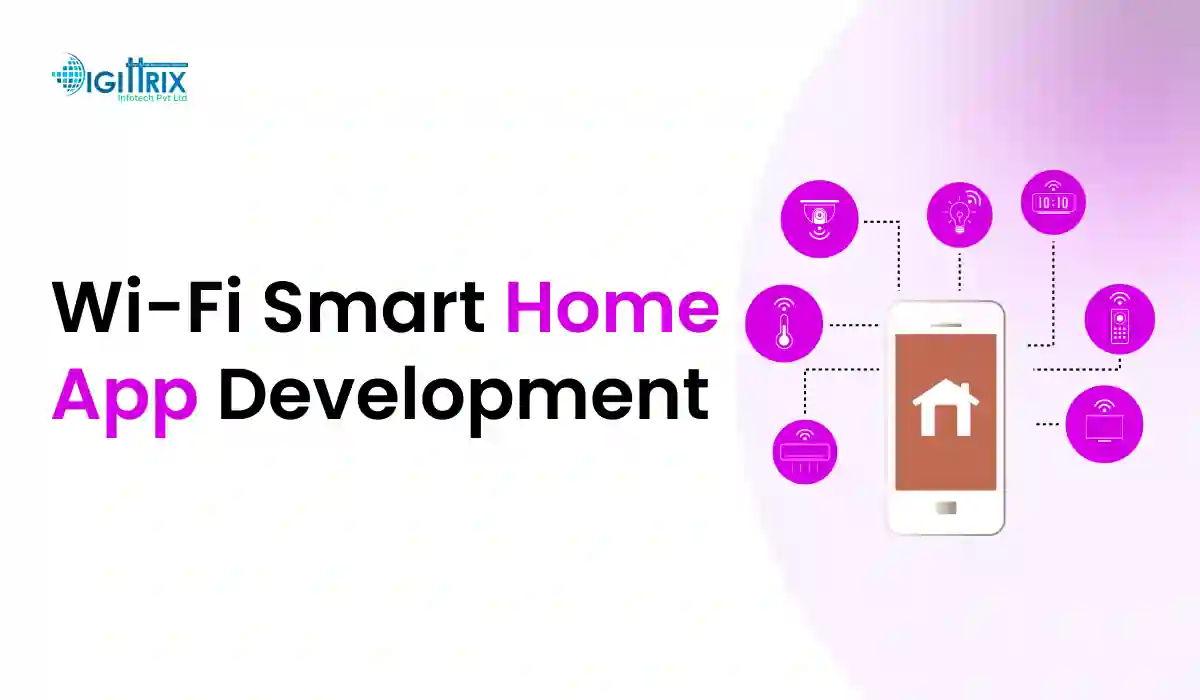Wi-Fi Smart Home Control Apps allow users to manage devices remotely, offering convenience, safety and automation through mobile-based control of lights, thermostats, and more.
Highlights
With Over 14 years of Experience in the IT Field, Helping Companies Optimise there Products for more Conversions

Smart homes are no longer a futuristic idea, they're a present-day reality. From turning on the lights with a tap to adjusting the thermostat remotely, homeowners now have more control over their environments than ever before. At the centre of this convenience is the Wi-Fi Smart Home Control App, an application designed to connect and operate devices such as bulbs, plugs, outlets, switches, and even blinds using your smartphone or tablet.
If you're considering building such an app, this article walks you through every aspect of the process, from idea to final product. It also covers the roles of technologies like Sonoff, Kasa, Philips, and Tuya, as well as systems like Google, Apple, and SmartThings. Statista reports show that the global smart home market is expected to reach $163 billion by 2028.
Facing hurdles in your digital transformation journey? Explore 7 common challenges and how to overcome them for a smoother transition.
A Wi-Fi Smart Home Control App allows users to connect and manage smart devices through their home’s Wi-Fi network. It can control a variety of products, including a smart bulb, dimmer, diffuser, garage door, door lock, panel, light switch, or even a smart thermostat like Tado or Wiser.
These apps are not limited to high-end homes. Even an affordable socket or plug from Geeni, Govee, or Wemo can be managed with the right app. Some popular protocols and products that apps support include SwitchBot, Broadlink, IR controllers, HS200, Tapo, and Anymote.
Whether it's switching off the LED lights, closing blinds, or scheduling a diffuser, everything can be managed remotely or even through voice assistants like Siri, Google Assistant, or Amazon Alexa Dot.
The rising demand for home automation presents a huge opportunity. More homeowners are investing in smart products such as controllers, modules, door locks, and even full home control panels. A Smart Home Manager App helps organize and operate all of these devices from one place.
For businesses, developing such an app not only meets a growing consumer demand but also creates new revenue opportunities through custom software development and mobile app development services. If you’re part of an app development company, this space can be very rewarding.
Whether it’s a basic socket control app or one supporting Wi-Fi lighting, the goal is to make everyday tasks easier, safer, and more energy-efficient.
A successful Smart Home Manager App provides features that help users take control of their home in simple ways. Here’s what you should include:
Users should be able to add devices quickly, whether it’s a smart plug, LED strip, or a garage switch. Make pairing straightforward via QR code, Wi-Fi auto-discovery, or manual input.
Allow the control of various devices from one dashboard: lights, sockets, dimmers, thermostats, and more. The layout should be simple, with toggles or sliders.
Users may want to group lights or create a scene like "Movie Night" to dim bulbs, close blinds, and start the diffuser all at once.
Allow users to set schedules. For instance, a Tapo switch can turn on the outlet every morning at 6 AM. Automation can also include device-triggered actions—for example, a thermostat adjusts when a door lock opens.
Push notifications alert users to activity, such as a switch being turned on or a garage door left open.
Support for Google, Siri, and Alexa adds hands-free control. The app can also support IR blaster integration like Broadlink, for controlling traditional remote-based appliances.
Given that the app controls access to the home, robust login authentication, encryption, and permission controls are critical.
Creating a successful Wi-Fi Smart Home Control App involves clear planning and careful execution. Here’s the full process:
Look at apps from Tuya, Kasa, Philips, and SwitchBot to see what features users like or dislike. Check what makes apps like Geeni, Wemo, and Govee popular. Morning Consult reveals that 69% of U.S. households own at least one smart home device.
The UI should allow easy control of every controller, socket, or panel. Use intuitive icons and make sure features like timers, remote access, and automation settings are accessible.
An app development company with experience in on-demand app development or mobile app development services can manage this stage efficiently. The app should handle remote access even when the user is outside their home network.
Integrate popular smart home brands and allow third-party device support. Protocols like Zigbee, Z-Wave, and Wi-Fi need to be accounted for.
Test every function—from turning on an LED bulb to scheduling a garage door close event. Focus on secure device pairing and encrypted Wi-Fi communication.
Launch the app on platforms like Google Play and Apple App Store. Maintenance includes updating device libraries, fixing bugs, and responding to feature requests.
If you're a business looking to build this type of app, partnering with an app development company offers multiple advantages. They can assist with:
Building a smart home app can be complex. Here are a few challenges:
The smart home sector is growing fast. Users now expect apps that work with devices like SwitchBot, Broadlink, and even legacy items controlled via IR remotes like Anymote. As new brands launch smart devices, there is room for an app that gives users a glimpse of complete home control from one interface.
Some users prefer brand-specific apps (like Wiser, HS200, or Apple Home), while others seek all-in-one control. An app that supports both types through custom modules and plug-ins can stand out. According to Statista, mobile app control is the preferred method for 54% of smart home users.
Developing a Wi-Fi Smart Home Control App offers an exciting opportunity in today’s tech-driven world. Whether you're building a simple light control app or a full Smart Home Manager App with support for bulbs, door locks, thermostats, panels, dimmers, and remotes, focus on ease of use, strong security, and broad compatibility.
By working with professionals who specialize in custom software development and mobile app development services, you can create a product that fits the current demand for smart living. A reliable app that supports popular brands like Tuya, Philips, Tapo, Wemo, and Google SmartThings can quickly gain trust and adoption.
For businesses and developers, this is a strong step into a future where every socket, controller, plug, and dot can be part of an intelligent home ecosystem.
In 2025, smart home technology will become essential for convenient and efficient living. Developing a Wi-Fi Smart Home Control App is a practical way to manage connected devices, improve home security, and simplify daily routines. Whether you’re a startup entering the smart home market or an established business looking to expand, having a customized app that fits your product and user needs is crucial.
At Digittrix, a trusted web and mobile app development company, we specialise in Smart Home Manager App development that matches your unique requirements. With over 14 years of experience, our expert developers work closely with you to design, build, and launch Wi-Fi Smart Home Control Apps that allow users to control lighting, heating, security systems, and other smart devices easily and securely.
Whether you need a mobile app for homeowners or a web-based dashboard for managing multiple properties, our team creates solutions that enable smooth device control, real-time monitoring, and user-friendly automation.
To start developing a Wi-Fi Smart Home Control App tailored to your vision, reach out to Digittrix at +91 8727000867 or email us at digittrix@gmail.com. At Digittrix, we don’t just create apps; we build custom smart home software that keeps users connected, comfortable, and in control today and beyond.

Do you need help in Mobile App development?




Join over 1500+ businesses we've already helped!
A Wi-Fi Smart Home Control App connects and manages smart devices like lights, plugs, thermostats, and switches over your home Wi-Fi network.
Devices such as smart bulbs, plugs, sockets, dimmers, thermostats, door locks, blinds, and garage doors can be controlled via the app.
Yes, most apps require a stable Wi-Fi connection for remote access and automation features, although some local control options may work offline.
Important features include device pairing, centralized control, scheduling, notifications, and voice assistant integration like Google or Siri.
Yes, with proper integration, the app can support brands like Sonoff, Kasa, Philips, Tuya, Wemo, and SmartThings for wide device compatibility.

©2025Digittrix Infotech Private Limited , All rights reserved.